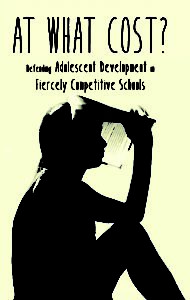
Does More ‘Free Time’ Mean More ‘Screen Time’ for our Students
After a recent presentation about my book At What Cost? Defending Adolescent Development in Fiercely Competitive Schools, an independent school health and wellness professional asked a provocative question:
“Dr. Gleason, you’re advocating for more free time for our students … but what if we give them that free time and they spend it all on their phones or other screens, just killing time on Facebook or Instagram or Snapchat or whatever? Do you think giving students more free time will just enable to have even more screen time?”
It is true – as hundreds of those I interviewed for At What Cost? have acknowledged – that students in competitive schools all around the world are incredibly overscheduled and are frequently overwhelmed. From this perspective, it seems only natural to recommend more “free time” in students’ otherwise frenetic schedules.
More Screen Time Can Be Damaging to Teen Brains
However, as recent studies have revealed, having “free time” that is consumed by “screen time” is not only unhealthy, it may even be damaging to adolescents’ still-developing brains, and by extension, their social and emotional development.
Consider the recent 60 Minutes episode entitled “Brain Hacking,” in which Tristan Harris, a former product manager from Google, explained that “Silicon Valley is engineering your phone, apps and social media to get you hooked.” Harris is a tech insider who “publicly acknowledges that the companies responsible for programming your phones are working hard to get you and your family to feel the need to check in constantly,” a phenomenon recently termed as “brain hacking.”
In light of this concern, Harris asked the question, “When these features are designed, are they being designed to most help people to live their lives, or are they being designed to hook people into using the product?” Harris also reminds us: “Never before in history have a handful of people at a handful of technology companies shaped how a billion people think and feel every day with the choices they make about these screens.”
According to Harris, technology designers “are shaping the thoughts and feelings and actions of people … they are programming people [and] the constant distractions of apps and emails are ‘weakening our relationships to each other,’ and ‘destroying our kid’s ability to focus.’”
Screen Time Produces Chemical Changes in Brains
Two years ago, in a May 2015 New York Times article featuring Dr. Delaney Ruston and her then released documentary film, Screenagers: What To Do About Too Much Screen Time, Dr. Ruston highlighted the role that dopamine plays in reinforcing cell phone use among teenagers. According to Dr. Ruston, “Screen time releases the chemical dopamine in the reward centers of the brain, and there is no other time in life when you’re as susceptible to that pleasure-producing chemical than in adolescence.”
Dr. Ruston highlights what I emphasize in my book, that the entire adolescent era is a “developmental sensitive period” – also termed “a critical period” – defined as a phase of human development when individuals are maximally sensitive to environmental experiences in the process of shaping and molding their brains.
Finally, in a January 2017 interview with Tom Bilyeu on Inside Quest, Simon Sinek not only reinforced the dopamine addiction inference but further described dopamine as the chemical most responsible for other addictions, too, such as to drinking alcohol, smoking cigarettes and gambling.
Cell Phones as “Dopamine-Producing Devices”
In that interview, Sinek referred to cell phones as “dopamine-producing devices” that have had a negative impact on millennials’ overall development, particularly pertaining to their sense of job satisfaction and to the strength of their relationships. Sinek rightly proclaimed that “job satisfaction” and “strong relationships” cannot be learned instantly from an app on a cell phone, but that these are human experiences that reflect continuing growth and development, or as Sinek explains, “these are slow, meandering, uncomfortable and messy processes.”
From these three related sources, we recognize that there are two major issues at play.
The first issue involves a problem of addiction – that for adolescents, because of their developmental vulnerability, there is “no other time in life” when they’re as susceptible to the addictive qualities of their “dopamine-producing devices.”
The second issue involves a problem of adolescents not developing the habits, mindsets, and skills that lead to more sustained well-being – to social and emotional strength and competence – because they’re spending too much time on their phones. While these are two different issues – addiction and development – they are closely interwoven, and for that reason, more difficult to resolve, too.
We return to the question: “If we give students more free time, are we just enabling them to spend even more time on their phones, just killing time on Facebook or Instagram or Snapchat or whatever?” From my perspective, the real answer is that there are not any easy answers. That said, however, there are answers, but like Simon Sinek’s explanation about “job satisfaction” and “strong relationships,” the answers to this “free time – screen time” question also reflect the “slow, meandering, uncomfortable and messy processes” that are inherent to any process of growth and development.
Goal of Free Time is to Promote Health and Well-being
Since the purpose of giving students more free time is to promote health and balance amid their otherwise unhealthy and frenetic schedules, it is this purpose that needs to remain central. Therefore, as we give students more free time, we also need to be more explicit about how we think they should use it.
- We need to set guidelines and have discussions with students about why we want them to have more free time.
- We need to talk with our students about the dopamine addiction research, and then emphasize their responding to that research in health-enhancing ways.
- We could encourage students to take breaks and talk – in person – with a friend or two.
- We could urge students to sit alone quietly – meditating, observing, resting, relaxing – without “checking in” to their devices.
- We could suggest that students take walks; read for pleasure; listen to music; write letters or draw pictures.
In fact, we could recommend that our students do anything that promotes their steady growth and development, either through direct human interaction, or through mindful meditation, exercise, reading, writing … or simply, by going out to play!
This question is quite complicated because it involves closely interwoven problems concerning features of addiction and development. These two phenomena, while predictable in certain ways, are experienced differently in ways that reflect adolescents’ unique school environments and life circumstances. For this reason, as noted above, no easy answers exist; no single list of rules, regulations or remedies can be applied to this issue that would address it uniformly.
Instead, in the absence of such technical solutions, the answers to this question have to be learned – realized and reinforced over time – as the adolescents who are experiencing these phenomena not only comprehend the complexity of the issues, but also, as they engage and continue health-enhancing activities, such as the ones identified above.
Essentially, if adolescents do this – guided by the adults’ wise direction – they will adapt. Under such intentional circumstances, adolescents will slowly grow and develop gradually, meandering sometimes uncomfortably – but still determinedly – toward more stable, healthy and successful lives.

